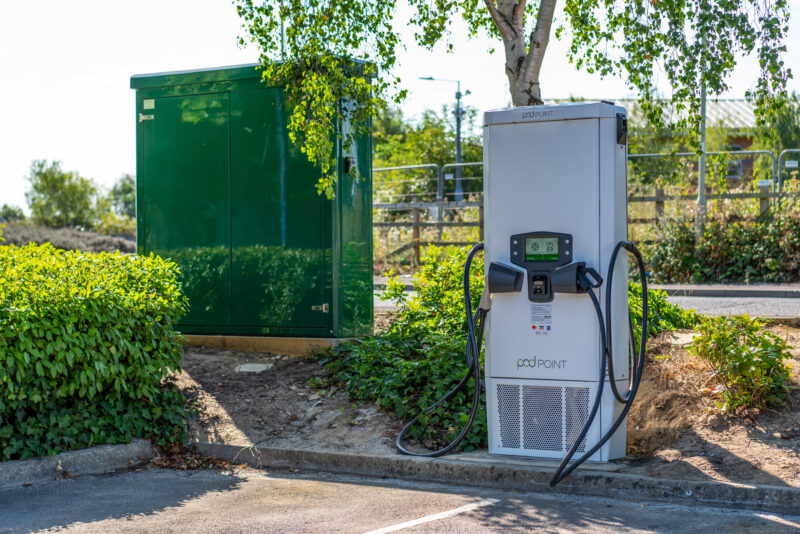How DC Charging Works
A guide explaining the pros and cons, differences to alternating current charging and suitability for different electric vehicle drivers.
Last updated: Aug 02, 2024 • 5 min read

Summary
Direct current (DC) charging is faster and more efficient than alternating current (AC) charging, which is why rapid chargers use DC.
While DC fast chargers cost more than slower charging options, they are usually found along motorways or in cities, making them a convenient choice for quick charging stops.
Summary
Direct current (DC) charging is faster and more efficient than alternating current (AC) charging, which is why rapid chargers use DC.
While DC fast chargers cost more than slower charging options, they are usually found along motorways or in cities, making them a convenient choice for quick charging stops.
Introduction to DC fast charging
DC fast charging is a charging method that tops EV batteries up quickly, some in as little as 30 minutes. Unlike AC charging, which is slower and commonly used for overnight charging at home, DC fast charging is designed for short charging stops, making it an ideal option for long road trips.
While DC fast charging can be convenient, it comes at a price. This type of charger typically costs more to use than slower AC chargers, as it’s typically larger, much more complex, and requires a high power connection to the energy grid. Plus, frequent fast charging is not recommended because the higher current puts more stress on electric car batteries, negatively affecting battery performance and durability. It also puts increased demand on the electricity grid, which can result in higher carbon emissions.
So, if you can, use AC charging for your day-to-day needs and save DC charging for long road trips or emergencies.
The pros and cons of DC fast charging
DC fast charging has its pros and cons. Here are some of the key points you should know:
Pros:
Speed: Less time waiting around, so you can get moving quicker.
Convenience: In places where drivers are looking for a short pit-stop.
Short waits: Minimal disruption to your day.
Cons:
Cost: More expensive to use than AC chargers.
Compatibility: Not every EV can use fast charging.
Environmental impact: Increased power demand can lead to higher carbon emissions.
Limited availability: Less common in remote areas.
Battery degradation: Potential negative impact on battery health.
What is the difference between AC and DC charging?
The key difference is that DC is faster than AC charging. When using direct current, energy can be stored in the battery without being converted, which makes the process more efficient and saves time.
However, to store energy from alternating current, an onboard charger in the EV has to convert it first, which leads to longer charging times.
Can every EV use DC fast charging?
Compatibility depends on your battery system, so not every EV is able to use DC fast charging. Some popular EV models that support DC fast charging include the Tesla Model 3, Kia e-Niro and Volkswagen ID.3.
The best way to find out if your electric vehicle is compatible is to consult the manual or check our electric vehicle guides to find information about your model and make.
What factors impact the rate of DC charging?
A variety of external and technology-related factors can impact the rate at which DC charging is performed. You’ll want to consider these next time you’re low on charge and plan to top up using a DC charger:
Temperature
If it’s extremely cold or hot, you may find that charging takes longer than usual because every EV battery has an optimal operating temperature. When temperatures fall outside this range, charging may be slower.
Power rating
Not all DC fast chargers are made equally. Power ratings can vary, from 24kW at the lower end to 350kW at the top of the range. Any charger with a power rating higher than 43kW is typically classed as a rapid charger. The higher the power rating, the faster your electric vehicle will charge, as long as it is compatible with the given kW rating.
State of Charge (SoS)
This is how much charge is left in your EV battery, usually displayed in percentages. A battery that has little energy left will charge faster than a battery that is almost full. DC chargers work fastest between 20% to 80% SoS. Outside this range, DC fast charging rates may be lower.
Busyness
A busy charging station, used by multiple EVs at the same time, will charge your car more slowly. The reason for this is how the power supply is set up. DC fast chargers, and any other chargers, are likely connected to the same electricity supply. If demand is higher, every charger connected to the same source will slow down.
Use DC fast charging to your advantage
Now you know how DC fast charging works, you’ll be able to make the most of this option. The speed and convenient location of these chargers is ideal for a quick top up while on the road. Fast charging is best reserved for occasional use, as this way you’ll avoid higher charging costs and preserve your battery health for longer.
If you have access to an AC charger, whether that’s on your drive at home or in a local overnight car park, it’s still the best option to recharge your EV battery on a day-to-day basis. Leave it plugged in while you rest, this way you’re charged and ready to go when you need it.

